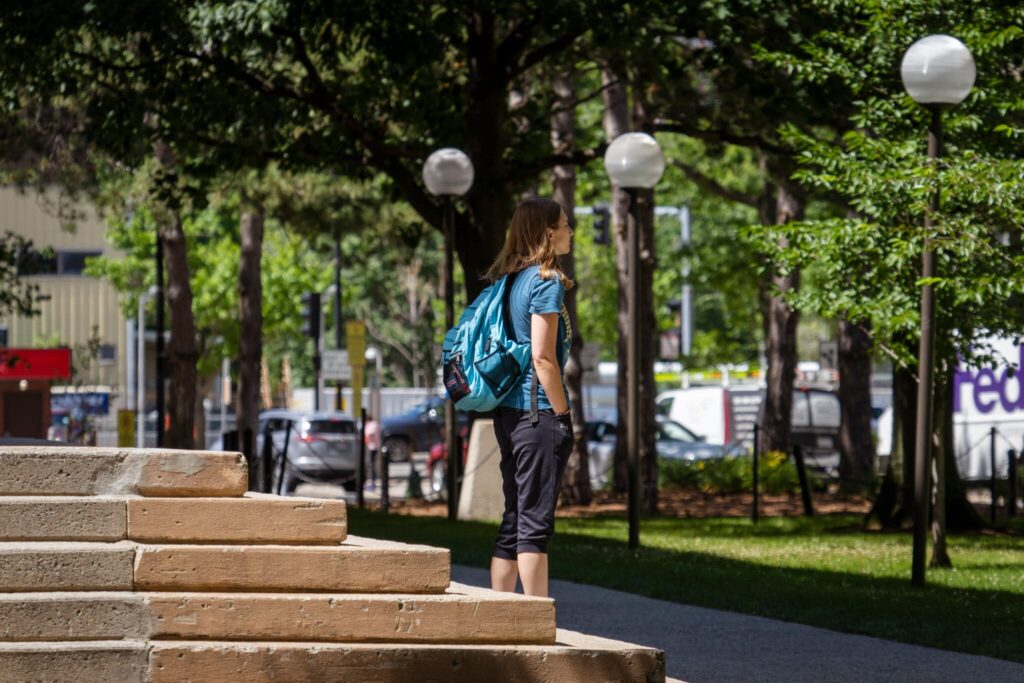First-year files: Orientation eases the transition
August 30th, 2022Transitioning from high school to college, or middle school to boarding school, is a big adjustment. Students move from the familiar routine of living at home and attending school nearby to a completely new and unfamiliar world, often pushing them out of their comfort zone. Luckily, nearly all new college and boarding school students are in the same boat.
In today’s blog post, Lilly, a previous Shrop Ed advisee, shares her experience as an incoming first-year at Boston College. Lilly’s reflection on BC’s summer orientation program reminds us to keep an open mind, seek connections with others and participate in campus activities. This will certainly help students navigate challenges ahead.

Lilly’s first-year orientation experience from Boston College is shared below … and we’re grateful for her willingness to write for our blog. We wish Lilly and all of our advisees a great academic year ahead!
After my high school graduation in early June, I had only 11 days until my College Orientation. Not much travel was required since my college happens to be less than a mile from my house. Nonetheless, college is still an entirely new and unfamiliar world into which I am entering.
Upon arrival at the Thomas Moore Apartments (the sophomore dorms in which we stayed), I was instantly greeted by numerous kind Orientation Leaders. They are current students at Boston College who were there to answer any questions anyone might have. The lobby was crowded, as dozens of rising freshmen and their parents buzzed around, getting room cards and information pamphlets. Some formed small groups and talked amongst themselves, while others nervously clung to their parents as they did in elementary school.
Despite being a social person who doesn’t usually struggle with meeting new people, I was still nervous entering this situation, and wondered if others felt the same way. I stayed in a 6-person suite with 5 very nice girls. The girl I shared a room with and I instantly ‘clicked,’ and she introduced me to her roommate for next year who is a nursing student like me. Right off the bat, I felt lucky and relaxed to have made new friends so quickly – it set a positive tone for the rest of the orientation. On the evening of our first day, we divided into groups of ten, which would be our “Small Groups” for the rest of the orientation. In our small groups we participated in ice breakers, shared where we were from and what our majors were. Just among our group of ten, we were from as close as a few towns over, and as far as Los Angeles, California. Also everywhere in between, such as Atlanta, Baltimore, Kansas City, and Philadelphia. Our career paths varied just as much, with majors such as nursing, finance, psychology, biochemistry, and marketing. We shared our nervousness and excitement, reassured about the fact that we were feeling similar emotions.
Throughout the orientation, our Small Group leaders introduced us to numerous resources we could access as students such as tutoring services, writing centers, and advisors to answer all of our questions. Over the course of the next few days, our small group interacted with other groups, and thus I met a lot of new people. There were large seminars as well, where we met some teachers and learned about the ‘Core Curriculum.’ We also learned more about the values of Boston College, such as leadership, sense of possibility, and student centered approach. The goal is for each individual to choose a career path of meaning and impact.
There was a concurrent parent orientation program. For my parents, this orientation was very different from their experience with my older sister. She started at BC in 2020 during the height of the pandemic. Nothing was in-person. Even her move-in was limited to a solitary 15 minute window. I could immediately sense how much they enjoyed being part of an in-person orientation. They enjoyed meeting other parents and especially the communal mass to celebrate the start of our BC journey.
In one of my favorite seminars, the story of ‘The Man with the Red Bandana’ was told. I have known about Welles Crowther’s heroics since a young age, but hearing it told in this setting was very moving. If you have not heard this story, I strongly recommend you look it up, because it is an incredibly powerful, real-life story of a BC alumnus who truly represents BC’s core value: service to others. Hearing it again reminded me, yet again, why I chose to attend BC.
We also registered for classes. First, we were divided into groups based on our majors, so I was in a “nursing” group of about 20 students. Several nursing professors presented a slideshow about our courses, explained the registration process, and then circulated the room as we worked on our schedule drafts. The next day those draft schedules were made official as we actually registered for our classes. The process was organized and help was there if needed.
In between seminars, group meetings, and games, we walked around and familiarized ourselves with the lay-out of campus. When school begins in the fall, I will recognize many familiar faces and feel more comfortable making the transition knowing that I’m not alone and I have many resources to help me along the way. I am most excited to continue to meet new people as I explore this new chapter of my life.
The beginning of school and the importance of a mental health check
August 16th, 2022Starting the school year can come with great excitement while also leaving some students overwhelmed or anxious. Navigating through these complicated feelings can be challenging, but it’s oh so important to keep your mental health in check. Practicing self-care and keeping the lines of communication open are just the tip of the iceberg for a healthy state of mind.

The article linked below from The New York Times provides a mental health checklist for students. This article is especially helpful for those going away to college. Locating the appropriate resources now is a proactive way to plan in case there is a need in the future. Although this article is written specifically for college students, it is a reminder to us all that it is okay to ask for support and make sure we are making healthy choices to keep our emotional well-being balanced.
Article linked below from The New York Times, published July 8, 2022 written by Christina Caron
Before Heading to College, Make a Mental Health Checklist
As fall approaches, new students will arrive on college campuses toting all kinds of things: luggage and school supplies, mini fridges and sports equipment. But in the midst of the preparation for move-in day, many have not considered what tools they will need to support themselves emotionally.
In other words, what can they do to protect their mental health?
In a 2017 survey of more than 700 parents and guardians, over 40 percent said they did not discuss the potential for either anxiety or depression when helping their teenagers prepare for college or postsecondary school. In addition, most of the caregivers said mental health services on campus were not a priority when choosing a school.
First-year files: Semester at Sea
August 2nd, 2022Have you ever considered studying abroad in college? What a great opportunity to immerse yourself in a new culture and lifestyle while continuing to take courses to complete your degree. The opportunity to study in a different country can be one of the most defining experiences of your lifetime.
Some students put study abroad programs at the top of their priority list when searching for the right school. If this is important to you, make sure to include the qualities of a study abroad program in your college search. Many colleges offer possibilities, although students often find programs offered by other institutions and transfer credits back to their home colleges.
When creating a college list, Samantha, a previous Shrop Ed advisee, set her sights on colleges with great study abroad programs. However, like so many things in life, plans changed and she found Semester at Sea. Her experience is very intriguing and I am grateful she was willing to share her deep reflections on the experience with us.
Samantha’s Semester at Sea….
When envisioning my perfect college experience, I had always dreamed of studying abroad. In researching colleges, I was drawn to several universities solely for the dazzling study abroad programs they offered. However, I quickly became sidetracked by all the shining bells and whistles – school spirit, research labs, clubs and organizations, Greek life, dormitories, and much more. By the time I enrolled at the University of Texas, I was completely unaware of the abroad experiences my home university had to offer.
When I began searching through UT’s study abroad opportunities, I was underwhelmed by the programs offered and confused by how few pertained to my major or offered the courses I needed for my degree plan. To make matters worse, programs were swiftly being canceled due to COVID-19. The pandemic threw a wrench in many college sophomores’ and juniors’ plans, as study abroad programs were dropped one after the other. I had just about assumed that my study abroad dreams were over.
Fortunately, one of my floor mates suggested that we both apply to a study abroad that happened to be unaffiliated with our university – Semester at Sea is a “multi-country study abroad program on a ship open to all students of all majors, emphasizing global comparative study.” What photos and words on a page cannot explain is the truly unforgettable gift Semester at Sea is for 400+ students a semester.
This study abroad program is accredited by Colorado State University, which made it easy to transfer credits back to UT, and offers courses from Oceanography to Economics. The wide array of courses makes it possible for just about any college undergraduate to find just what they are looking for. Professors bring a wealth of knowledge, energy, and creativity. Classmates come from countries that many have never even heard of. Overall, I had the opportunity to study, sleep, eat, swim, play, and relax on a cruise ship turned college campus, the MV World Odyssey. And best of all, I didn’t just have the opportunity to visit one country, but rather sixteen varying countries and cultures.
Growing up, I traveled internationally several times with my family. Semester at Sea offered an experience in which I could experience countries I had previously visited through a new perspective and explore unfamiliar countries, as well. By the end of my experience abroad, I had traveled to Italy, Greece, Cyprus, Croatia, Malta, Spain, Gibraltar, Portugal, France, Scotland, Sweden, Denmark, Germany, the Netherlands, England, and Morocco. I made amazing friends, countless memories, and unforgettable experiences along the way.
With all the unforeseen challenges we experienced while navigating many different time zones, I prioritized quick calls home after every in-port experience. These calls also allowed me to update my family members on my travels in the process.
In giving advice to younger students considering study abroad, I would have to say, “lean into the discomfort.” Applying and eventually embarking on a study abroad experience will inevitably push you outside your comfort zone. Fortunately, this is the very point of studying abroad. In the midst of all the potential discomfort, you will learn to trust in your abilities, recognize your strengths, and view each day as an opportunity to absorb the wisdom around you, all while having a wonderful, gratifying experience. You will also learn to find comfort in newfound friendships, supportive professors, and communication with family members back home. In short, the study abroad experience is not only exciting but also challenging, and you will learn to love both.
Through my academic voyage with Semester At Sea, I cultivated three practices that I have implemented into my daily routine. Firstly, while studying abroad, I grew to prioritize a healthier work-life balance. Life on a ship offered a significantly different change of pace in which I was able to stay true to my academic responsibilities but also prioritize rest, healthy eating, and recreational time with friends. Back in Austin, I plan to follow a healthier routine in which I prioritize eight hours of nightly sleep and devote time to activities that genuinely make me happier, including playing tennis, cooking new meals, and spending time with friends. Through my experiences, I quickly began to view our world as a treasured gift, worthy of preservation, exploration, and study. People often say, “you learn something new about the world every day.” Through my academic voyage, I challenged myself to learn three new things a day – one new thing about myself, one new thing about a friend next to me, and one new thing about our big wide world. I have brought this practice home and am reminded of “The Big Three” via a sticky note on my bathroom mirror.
My many perspective changes are just small results of the impact Semester at Sea has had on me. I have never been more embraced by a community, eager to absorb my surroundings, or genuinely excited to learn. I can also confidently say that the experience cultivated empathy, challenged my perspective, and led me to absorb more information in my singular semester abroad than in all my previous five college semesters combined. I’m happiest to say my study abroad friends, memories, and lessons learned will surely last a lifetime.
Summer accomplishments: Common App and main essay
July 19th, 2022Time flies when you’re having fun and this summer is no exception, so we’re thrilled to see seniors get a jump start on college application work! Many have begun working on the Common Application and are aware that the site will be closed briefly at month’s end for its annual “summer refresh.” When the site becomes available again on August 1st, colleges’ new supplement questions will appear. Rest assured that students’ work within the main Common App portion of their accounts will resurface then, too.
Students who have worked on anything in the “My Colleges” tab of the Common App, or anything involving recommenders, should follow steps shared below by the Common App.
Each year on August 1, Common App launches our refreshed application with updated information, including any new questions and new colleges. Students will need to sign in and refresh their Common App accounts for the new cycle.
Many colleges change their questions from year to year, so if students started working on responses to college-specific questions, they should sign in before July 27 and take the following steps:
- Save any responses to college-specific questions or writing supplement questions somewhere outside of Common App. We recommend using Google Drive or similar storage apps.
- Document counselors, teachers, advisors, and other recommender names and emails outside of Common App. Students will need to re-add and re-invite these individuals if they intend to apply after August 1.
Heading into the fall semester with a few things checked off on your application list will certainly help ease some of the stress related to application season. Essays can be the most time-consuming part of the process, so you certainly don’t want to leave them to the last minute. The essay and college supplement questions are your chance to reveal yourself to each admissions staff in a more personal way. When it comes to essay tools and resources, no one does it better than The College Essay Guy. Linked below is an incredible guide to help you get started on brainstorming and drafting your way to a wonderful essay.
Personal statement guide linked below from The College Essay guy:
The Free Guide to Writing a Personal Statement
Welcome to the Guide.
I’m excited to be a part of your essay-writing journey. There are four basic parts of this guide.
Hour 1 – Everything you need to brainstorm a topic and structure your essay.
Hour 2 – How to write a Narrative or Montage Essay with a few sample essays.
Hour 3 – Writing the first draft and getting some initial feedback.
Next Steps – I set you up to write an awesome draft of your Activities List and Additional Info section, point you in the right direction for getting started on your supplemental essays, and lots more.
I recommend that you bookmark this page so that it’s easy to access as you work through it. This is your home base throughout your essay writing process.



